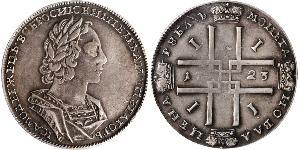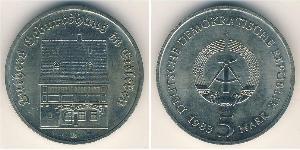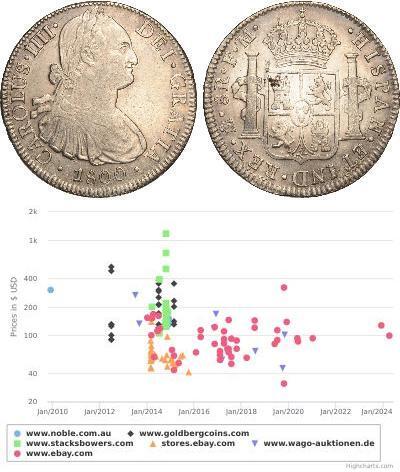(sold for $37.0)
1813, Russia, Emperor Alexander I. Beautiful Battle of Leipzig Medal. XF!
Mint Year: 1813
Medallist: Lauer
Mint Place: Nurnberg
Medallist: Johannes Stettner (Germany)
Condition: Tooled edge (drilled hole, where this piece was attached to a pendant), otherwise a nice XF with old completely preserved gold plating!
Reference: Diakov 368.2, Montenuovo 2387. Reichel 3261. Bramsen 1259.
Material: Brass (gold plated)
Weight: 12.97gm
Diameter: 33mm
Obverse: Facing vis-a-vis busts of the allied Emperors Alexander I of Russia and Francis I of Austria.
Legend: FRANZ.I.KAISER.V.OESTERREICH*ALEXANDER.KAISER.V:RUSSLAND
Reverse: Crowned russian imperial eagle flying over skyline of Leipzig, Napoleon´s army retreating to left.
Legend: DIE ENTSCHEIDENDE SCHLACHT DER ALLIERTEN BEY LEIPZIG.
Exergue: DEN 18-19. OCT: 1813
At your attention a beautiful and important brass medal issued to commemorate the historical Battle of Leipzig.
On 18 October, the Allies launched a huge assault from all sides. In over nine hours of fighting, in which both sides suffered heavy casualties, the French troops prevented a breakthrough but were slowly forced back towards Leipzig. The Sixth Coalition had Field Marshal Blücher (Prussian) and Crown Prince Carl Johan of Sweden to the north, the Generals Barclay De Tolly, Bennigsen (both Russian) and Prince von Hessen-Homburg (Austrian) to the south, and General Gyulay (Austrian) to the west.
The Prussian 9th brigade occupied the abandoned village of Wachau while the Austrians, with General Bianchi's Hungarians, threw the French out of Lößnig. The Austrians proceeded to give a demonstration of combined arms cooperation as Austrian cavalry attacked French infantry to give Austrian infantry time to arrive and deploy in the attack on Dölitz. The Young Guard Division threw them out. At this point, three Austrian grenadier battalions began to contest for the village with artillery support.
In the meantime, at the behest of his Swedish officers, who felt embarrassed that they had not participated in the battle, Bernadotte gave the order for his light infantry to participate in the final assault on Leipzig itself. The Swedish jägers performed very well, losing about 121 men in the attack.
During the fighting, 5,400 Saxons of Jean Reynier's VII Corps defected to the Allies. Napoleon saw that the battle was a lost cause and on the night of 18–19 October, he began to withdraw the majority of his army across the river Elster. The allies didn't learn of the evacuation until 7 a.m, and were then held up by Oudinot's ferocious street-to-street rearguard action in Leipzig. The retreat went smoothly until early afternoon when the general tasked with destroying the only bridge over the Elster delegated the task to a Colonel Montfort. The colonel in turn passed this responsibility on to a corporal, who, unaware of the carefully planned time schedule, ignited the fuses at 1 p.m, when the bridge was still crowded with French troops, and Oudinot's rearguard was still in Leipzig. The explosion and subsequent panic and rout resulted in the deaths of thousands of French troops, and the capture of many thousands more. During that unfortunate event, Poniatowski, the gallant Polish leader, drowned while crossing the river.
The Battle of Leipzig or Battle of the Nations, fought on 16–19 October, 1813, was one of the most decisive defeats suffered by Napoleon Bonaparte. The Battle of Leipzig was fought on German soil and involved German troops on both sides, as a large proportion of Napoleon's troops actually came from the German Confederation of the Rhine. It is considered the largest battle in Europe before World War I, with over 500,000 troops involved.
Casualties on both sides were staggering; estimates range from 80,000 to 110,000 total killed or wounded. Napoleon lost about 38,000 killed and wounded. The Allies captured 15,000 able-bodied Frenchmen, 21,000 wounded or sick, 325 cannon and 28 eagles, standards or colours, and had received the men of the deserting Saxony divisions. Among the dead was Marshal Józef Antoni Poniatowski, a nephew to the last king of Poland, Stanislaw August Poniatowski. The Pole, who had only received his marshal's baton the previous day, drowned trying to guard the French retreat. Corps commanders Lauriston and Reynier were captured. Fifteen French generals were killed and 51 wounded.
Out of a total force of 362,000, the Allies suffered approximately 54,000 casualties. Schwarzenberg's Bohemian Army lost 34,000, Blücher's Silesian Army lost 12,000, while Bernadotte's Army of North and Bennigsen's Army of Poland lost about 4,000 each.
The battle ended the First French Empire's presence east of the Rhine and brought the liberated German states over to the Coalition. The Coalition pressed its advantage and invaded France in early 1814. Napoleon was forced from the throne of France and exiled to the island of Elba.
In addition to the 91 m high Völkerschlachtdenkmal, the course of the battle in the city of Leipzig is marked by numerous monuments and the 45 Apel-stones that mark important lines of the French and allied troops.
Only 1$ shipping for each additional coin purchased!

|
Posted by:
anonymous 2015-10-04 |
1 Ducat Kingdom of the Netherlands (1815 - ) Gold
group has 17 coins / 16 prices
⇑















-300-150-4d4KbzbiDEoAAAFL22v6Agta.jpg)







